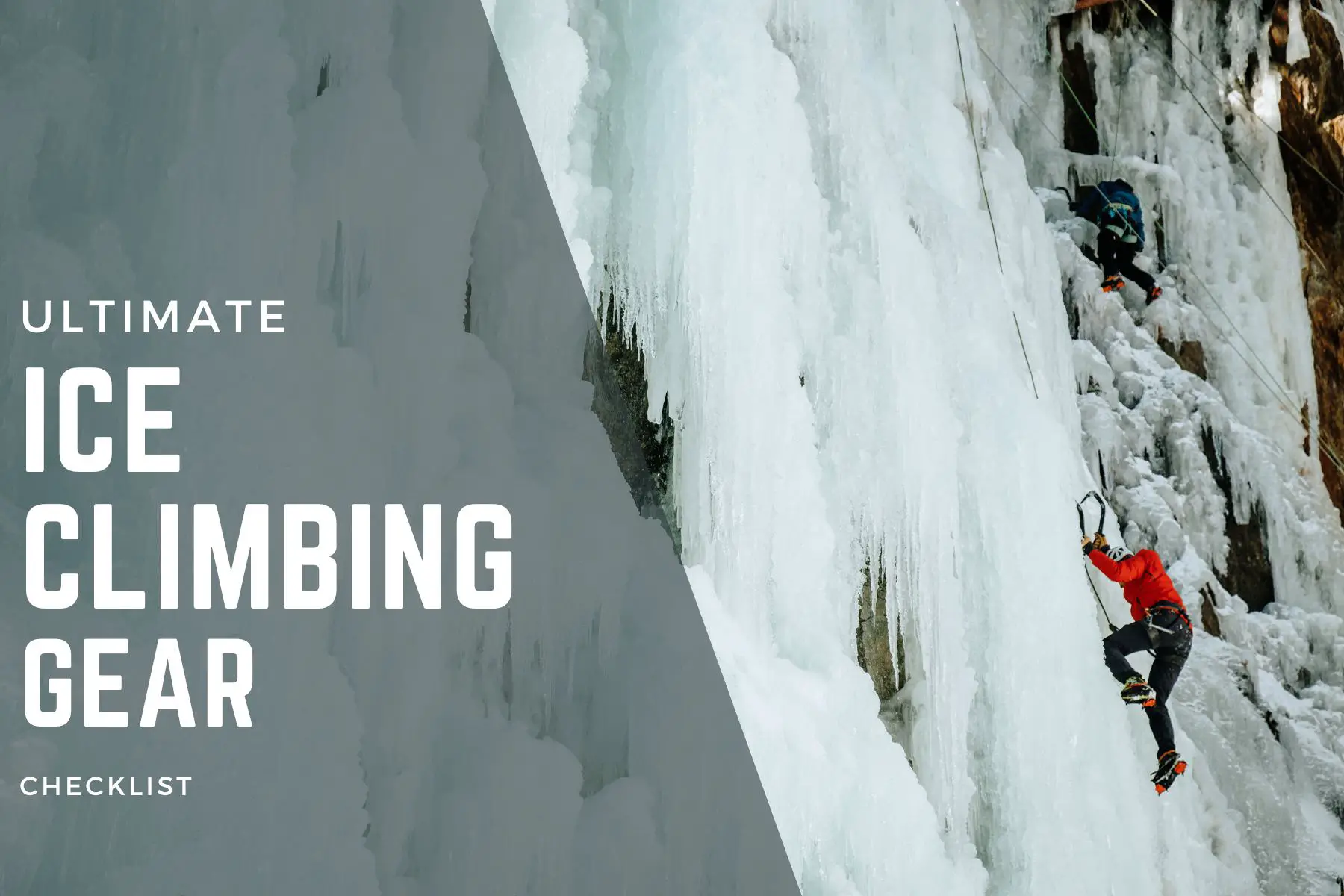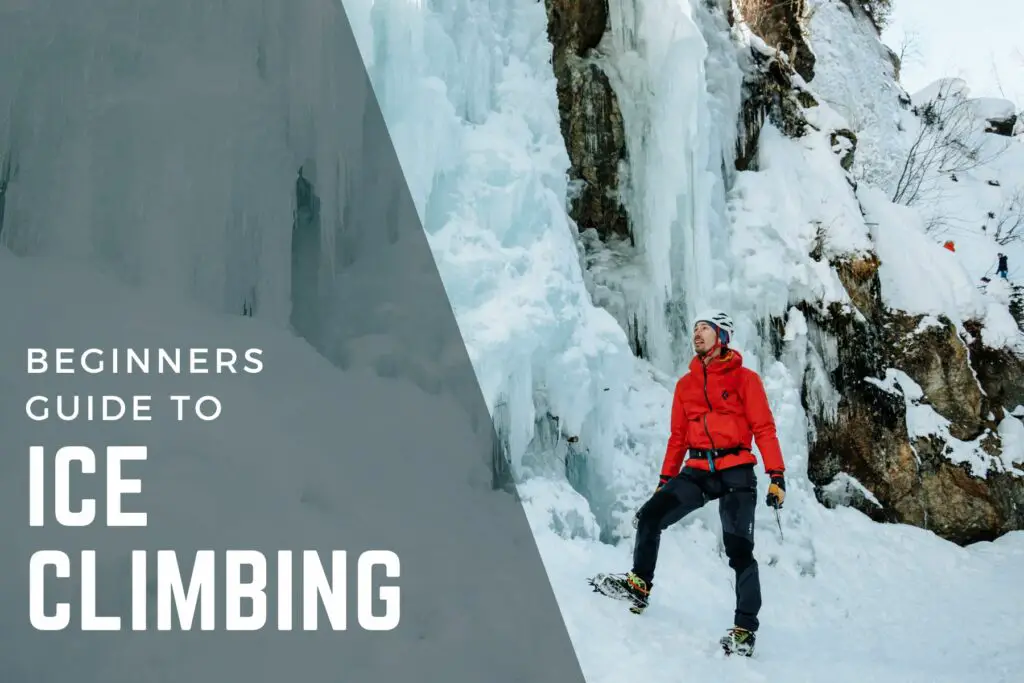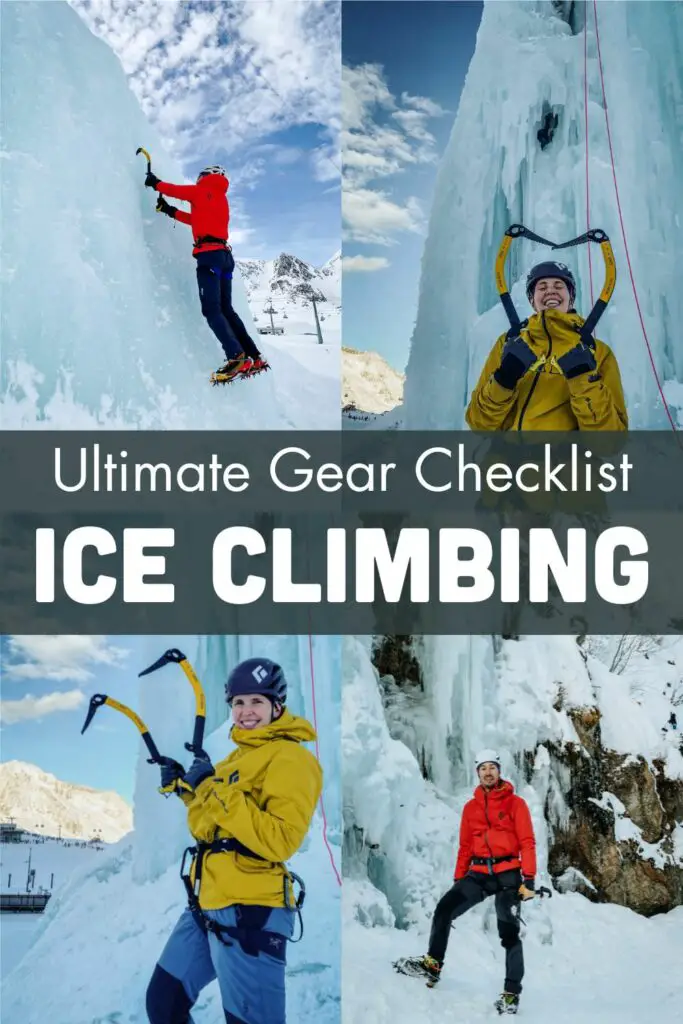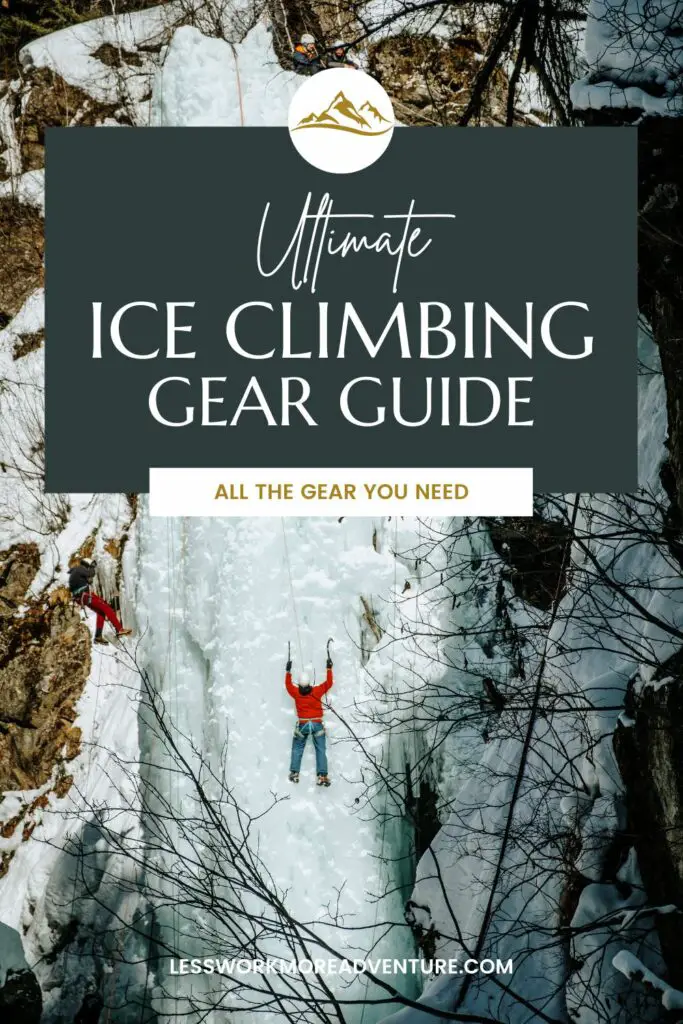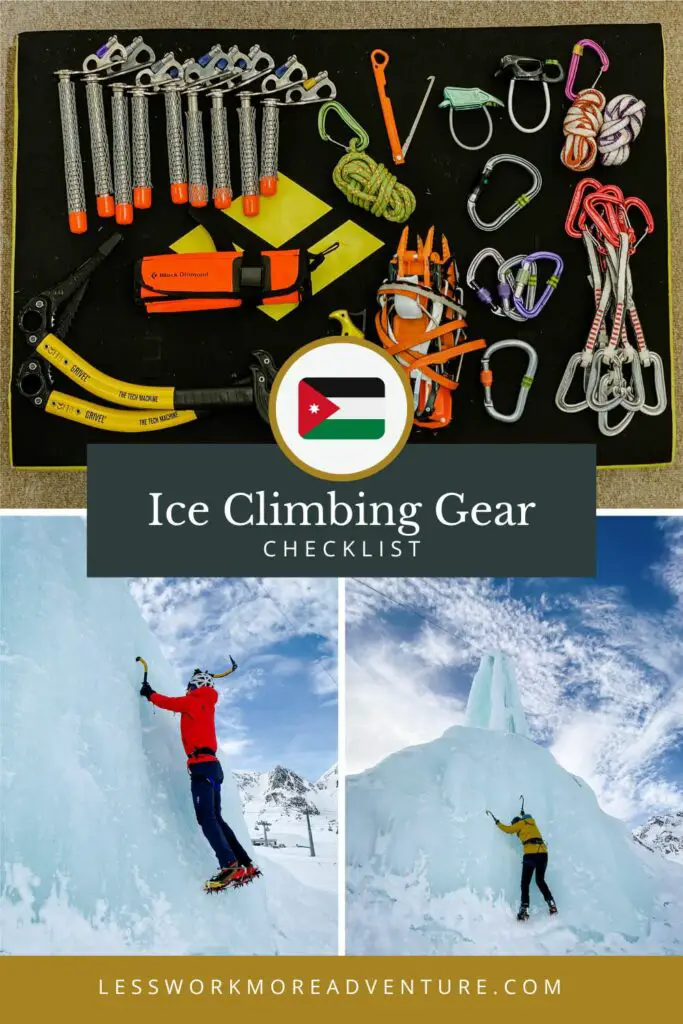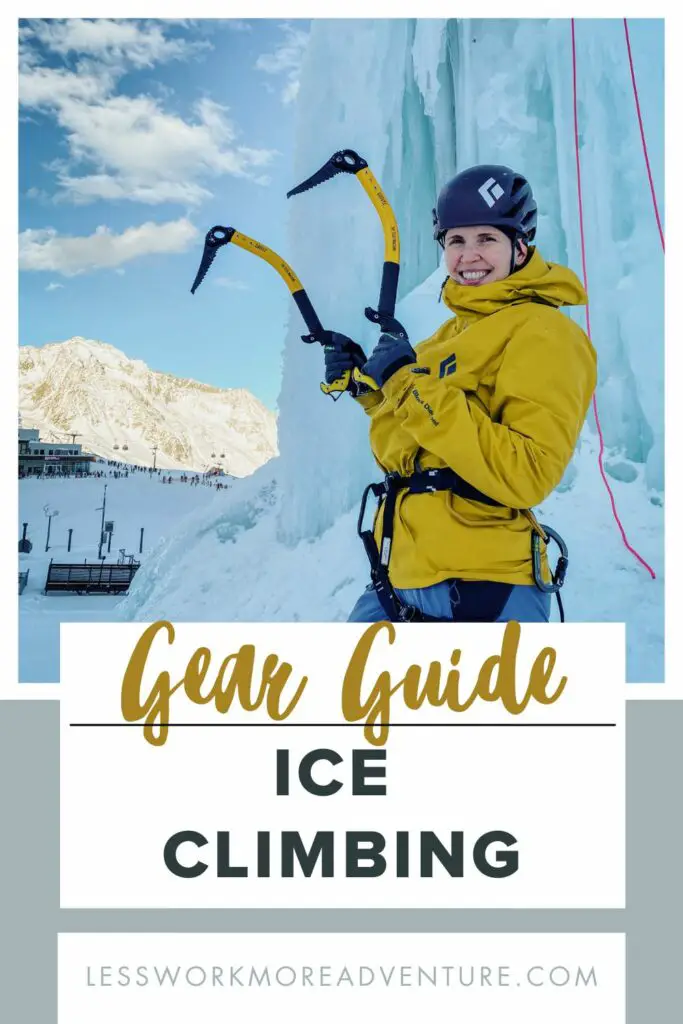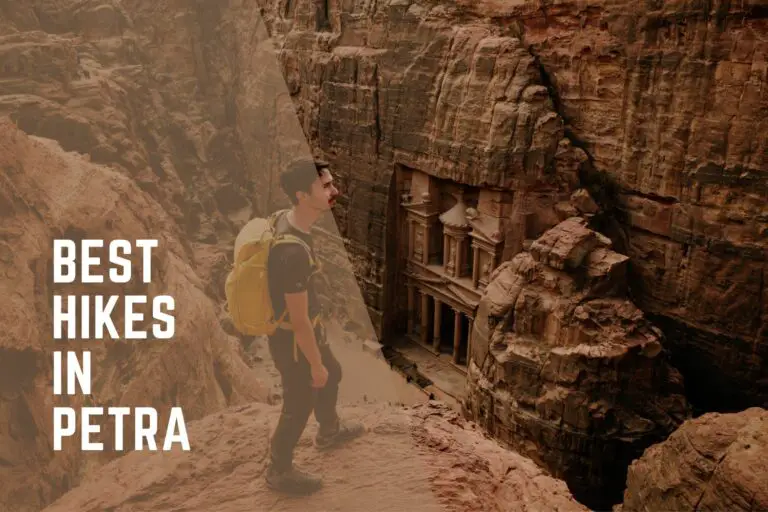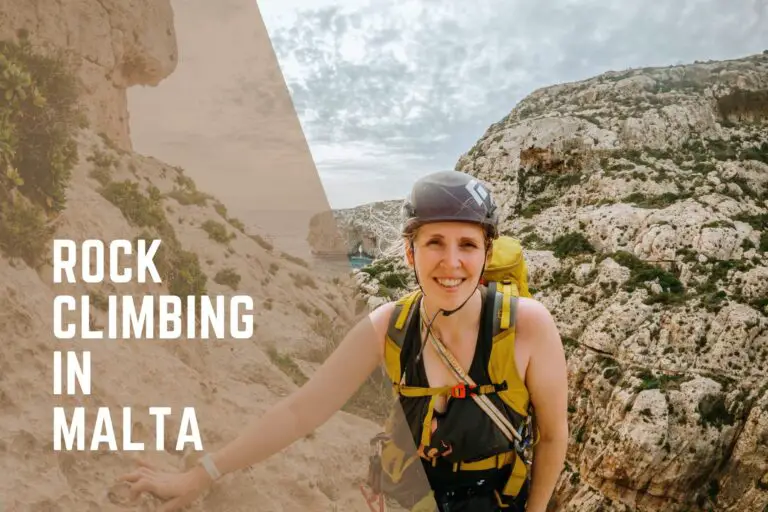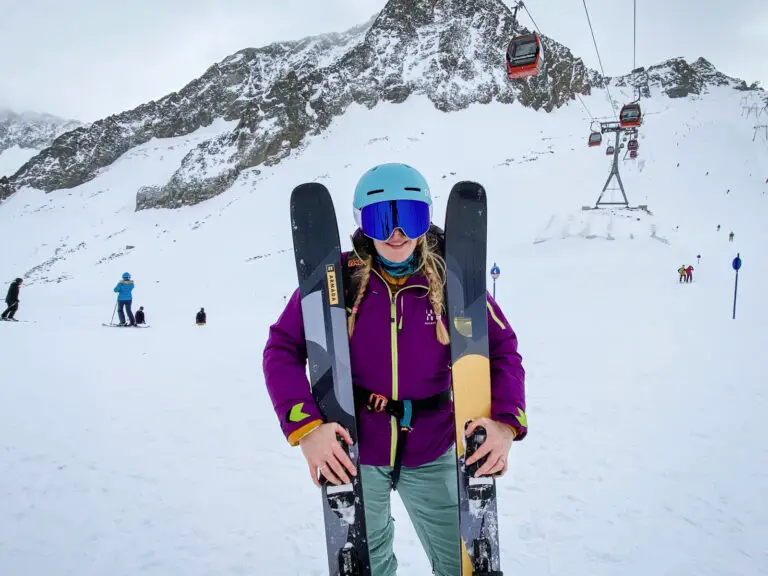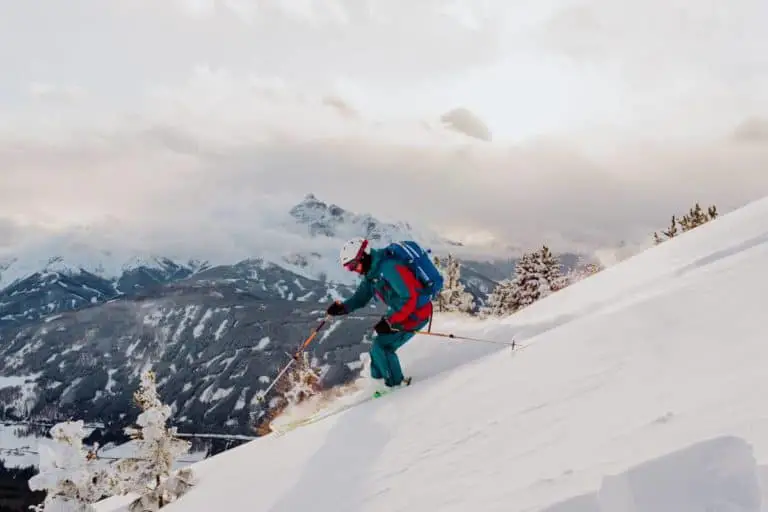Ultimate Ice Climbing Gear List
Disclosure: This post may contain affiliate links, meaning I earn a small commission if you decide to make a purchase though my links, at no additional cost to you, which I’ll probably spend on more outdoor gear and travel to cool places.
Table of Contents
Welcome to our blog post on the ultimate ice climbing gear! If you’ve tried ice climbing once or twice, and have used rental gear but you are now looking to invest in your own equipment so that you can start climbing on your own, then this post is for you. Ice climbing is a very gear-intensive sport, which, when you are just starting out, can be pretty daunting.
If you are already an outdoor sport climber or mountaineer, then you may already have some of the gear you need for ice climbing, however, there are a lot of things that are pretty specific to the sport that you’ll need too.
Below we’re covering all of the equipment you’ll need to start ice climbing independently:
Essential Ice Climbing Equipment
Ice Tools
The ice axes used for ice climbing are often referred to as “ice tools“, and are designed specifically for climbing steep ice. This makes them different from the ice axes that you may be familiar with if you’ve ever done any mountaineering or winter hiking.
They typically have a more aggressive shape with a curved shaft and are shorter in length than a mountaineering axe. Their blades are made from steel and their shafts are typically made of either aluminum or carbon.
A climber will always climb with a set of two (usually identical) ice tools.

Crampons
Similarly to ice tools, the crampons best suited to ice climbing are different from those used for mountaineering. If you are just starting out and already own mountaineering crampons, you may be able to use your existing crampons for ice climbing, but as you progress, you may want something more suited to climbing on steep ice.
Ice climbing crampons will have a semi-rigid form and are made out of steel. Many modern models offer a hybrid binding system, allowing you to adjust them depending on the type of boots you have. The semi-rigid construction is important for keeping them fixed in place and giving you a stable position when you are kicking at the ice (which you do a lot when you’re a beginner) and standing with your whole body just on the front points of the crampon.
The main difference between ice climbing crampons and mountaineering crampons is the front points. Ice climbing crampons have much more aggressive front spikes than mountaineering crampons since ice climbers spend most of their time on just the front points of the crampon. On specialist ice climbing crampons, these front points are often adjustable and interchangeable, letting you choose the angle of the points, as well as if you want two points or just a single point.
Ice Climbing Boots
The shoes you wear for ice climbing can make or break your enjoyment and performance, just like in regular climbing.
Here are a few key features to consider when choosing a boot for ice climbing:
- Warmth: Ice climbing can take place in extremely cold conditions, so it’s important to have a boot that will keep your feet warm. Look for boots with insulation and a sturdy, insulated liner.
- Waterproofing: It’s inevitable that you’ll encounter snow and ice while ice climbing, so it’s important to have a boot that will keep your feet dry. Look for a boot with a waterproof membrane, such as Gore-Tex.
- Support: Ice climbing involves spending a lot of time standing on the tips of your feet, so it’s important to have a boot that provides good support. Look for a boot with a stiff sole and a sturdy, supportive upper.
- Crampon compatibility: It’s important to choose a boot that is compatible with your crampons, as a bad fit may cause your crampons to come loose or move around, making climbing steep ice extra difficult.
- Fit: As with any shoe or boot, it’s important to choose a boot that fits well and is comfortable. Make sure to try on several different models to find the one that works best for you.
Winter mountaineering boots are usually ideally suited to ice climbing, as they are designed for snowy and cold conditions, are crampon-compatible, and usually have some insulation as well as waterproofing. Some manufacturers, such as Scarpa and La Sportiva also make more technical ice climbing boots.
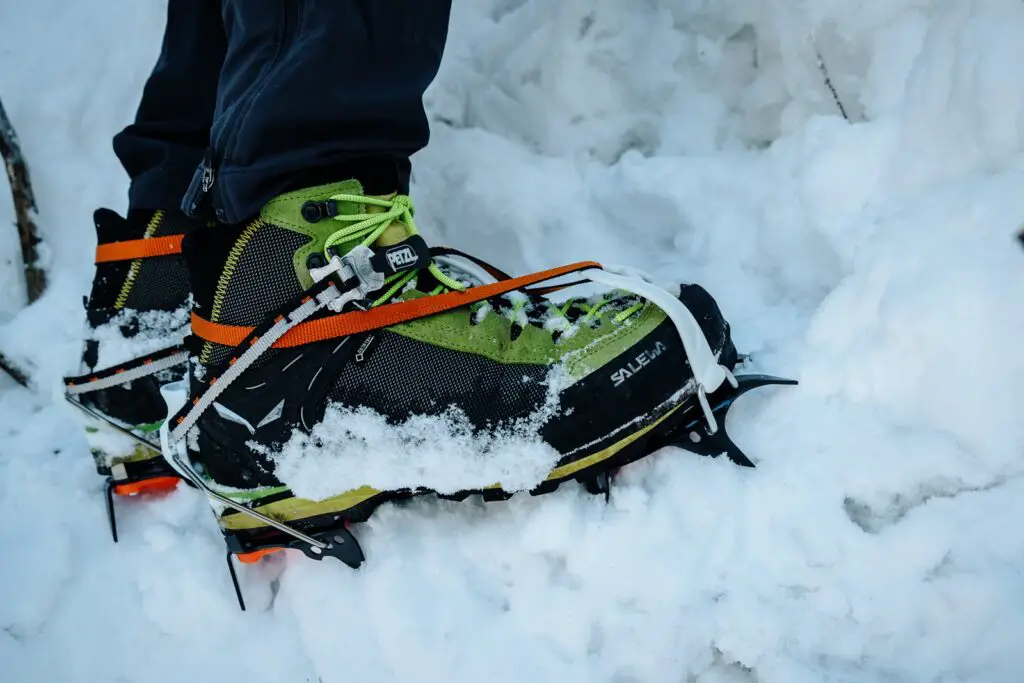
Harness
If you already own a climbing harness for sport or trad climbing, that‘s fine for ice climbing too. Once you advance in ice climbing, you may wish to purchase a more specialized ice-climbing harness, but at the start, it‘s not necessary.
An ice climbing harness is designed specifically for ice climbing and therefore has a few key features that set it apart from a standard climbing harness. These features include:
- Ice clipper slots: These are small slots located on the waist belt or leg loops of the harness that allow you to attach ice clippers (also known as carabiners) to your harness. These are used to attach your ice tools to your harness when you are climbing.
- Gear loops: Ice climbing harnesses often have additional gear loops to allow you to carry more equipment, such as ice screws, carabiners, and slings.
- Less Padding: Ice climbing harnesses often have less padding around the waist and leg loops than sport climbing harnesses. While this does mean they aren’t as comfortable, this does have a big benefit. In wet conditions (which are common when ice climbing), they don’t absorb water as much as padded harnesses.
- Durability: Ice climbing harnesses are often made with more durable materials than standard climbing harnesses, as they need to withstand the harsh conditions of ice climbing, as well as abrasion from sharp ice tools.
Overall, an ice climbing harness is designed to be more specialized and practical for ice climbing, while a standard climbing harness is more versatile and suitable for a wider range of climbing activities.
Some of the best climbing harnesses for ice climbing are:

Belay Device
If you sport climb, you‘re probably used to belaying with a semi-automatic braking device, such as a Petzl Gri-Gri. Since ropes in ice climbing can get wet and ice can freeze to the rope, an auto-blocking device runs the risk or jamming or freezing too.
The most popular belay device for ice climbing is a tube-style device, such as the Black Diamond ATC or Petzl Reverso. There have also been many great reviews of the Edelrid Giga Jul, however, we haven’t had the chance to test this ourselves.
Rope
When you start with ice climbing, you‘re going to be mostly climbing on a single top rope. The ideal diameter is between 9mm – 10.5mm, with dry treatment. When it comes to length, 60m is really the minimum, but you could also opt for 70m.
As you advance in ice climbing and start climbing in lead, you‘ll probably want a set of either twin or half ropes. These should also be dry-treated.
There are a few reasons why you might choose to use twin or double ropes for ice climbing rather than a single rope:
- Redundancy: Using two ropes provides an extra layer of safety in case one of the ropes becomes damaged (which can happen when you are surrounded by sharp ice tools and crampons). This can be especially important in ice climbing, where the consequences of a fall can be severe.
- Weight: Twin and double ropes are generally lighter than a single rope of the same diameter, which can be beneficial if you have a long approach, as each climber can carry one rope, spreading out the load.
- Rappelling: Double ropes can be useful when rappelling, especially from longer or multi-pitch routes, as they allow you to rappel longer distances.
- Reducing Rope Drag: When climbing with double ropes, you can clip both ropes into different pieces of protection, which can reduce rope drag.
It’s worth noting that twin and double ropes require a different belay technique than a single rope, and they may not be suitable for all climbing situations. It’s important to be familiar with the proper use of twin and double ropes before using them in the field.
Ice Screws
When you are first starting with ice climbing, you’ll only need 3-4 ice screws, which you’ll use for building top rope anchors and v-threads. Once you are ready to lead, you should have a rack with at least 12 ice screws.
Ice screws come in different lengths and materials, and what you use will depend on the type of climbing you plan to be doing.
Ice screws come in a variety of lengths, ranging from 7 cm to 22 cm. The shorter lengths, such as 7 cm and 10 cm, are best suited for thinner ice. The longer lengths, such as 18 cm and 22 cm, are better for thicker ice, top-roping, and building V-thread anchors.
Ice screws are typically made out of steel or aluminum. Steel screws are stronger and more durable, but they are also heavier and more expensive. Aluminum screws are lighter and cheaper, but they are not as strong and may not hold up as well over time.
The main difference between steel and aluminum ice screws is their strength and weight. Steel screws are stronger and can handle more weight, but they are also heavier and may not be as suitable for long routes where weight is a concern. Aluminum screws are lighter and may be easier to carry, but they may not be as reliable in certain situations.
Clipped into your ice screws, you’ll use quickdraws since you don’t clip your rope directly into the screw.
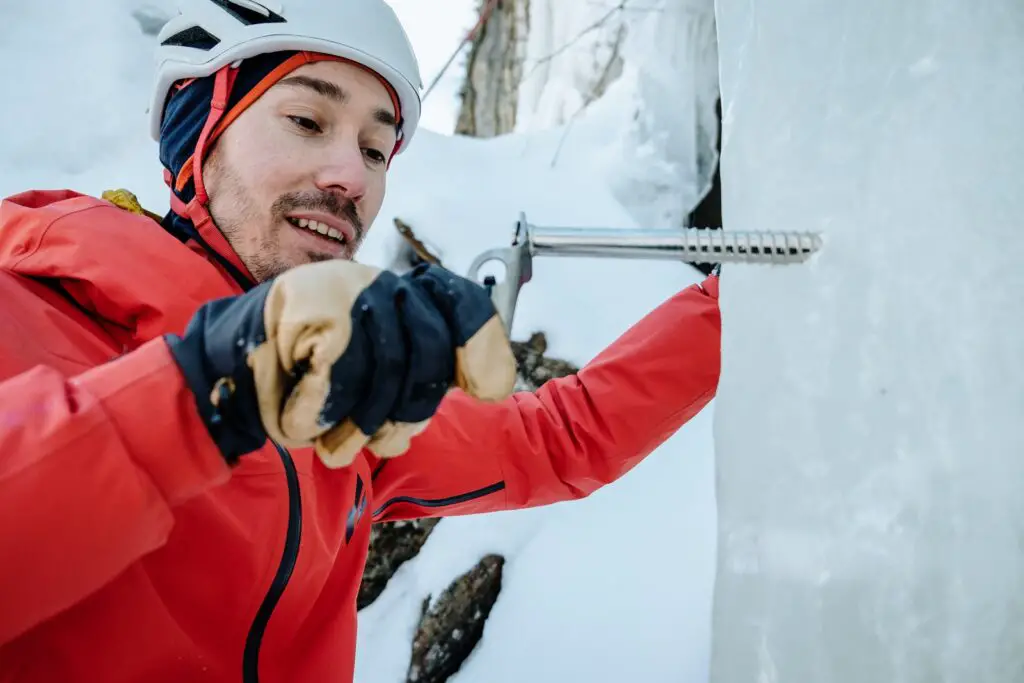
Helmet
A climbing helmet is needed for ice climbing. Climbing helmets are specially designed to protect you from rocks or ice that may fall from above.
Additional Ice Climbing Gear & Accessories
On top of the main pieces of gear that you need for ice climbing, there are also a number of smaller pieces of ice climbing gear that you’ll want to start adding to your rack to be safer and more efficient when climbing independently (aka not with a guide who brings it all with them).
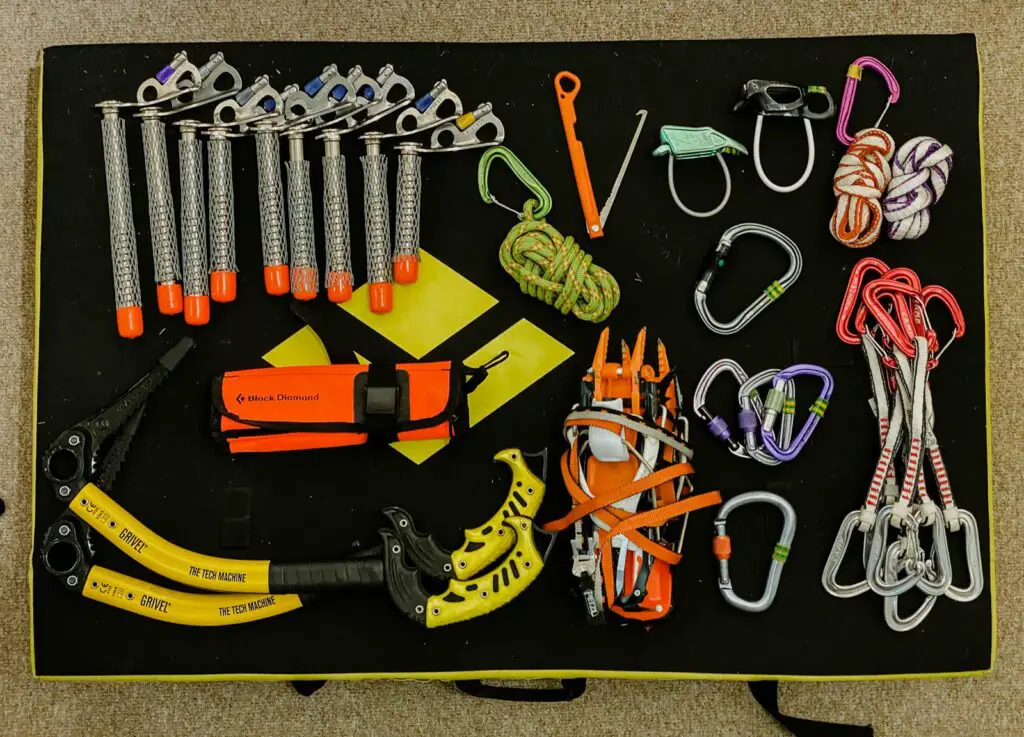
Threading Tool
When you are building v-thread anchors, you’ll need a threading tool to help you pull the cord or rope through.
Our threader of choice is the Petzl Multihook, as the hook clips onto your harness, can be safely stored away, and has a small blade for cutting ropes as needed.
Accessory Cord & Slings
When you are building anchors in the ice to top rope or rappel from, you’re often going to use a length accessory cord. For ice climbing and mountaineering anchors, the cord should be at least 6mm thick.
It’s also helpful to have a couple of Dyneema slings in your kit bag too, for if you need to make yourself safe while re-building an anchor.
Lanyard For Ice Tools
Some climbers like to have their ice tools attached to them with some kind of lanyard or leash, while others find these get in the way and climb without anything to prevent them from dropping one (or both) axes.
When we first started ice climbing, we didn’t use a lanyard. But one day Menno dropped an ice tool whilst putting in an ice screw, and from that moment on, we decided to buy one.
We chose the Petzl V Link, as it’s extremely lightweight.
Quickdraws
If you already climb, you will probably already own a selection of quickdraws. As you progress to longer routes, multi-pitch ice climbing, or routes with a long approach where every gram counts, you may choose to add some super light alpine quickdraws to your rack.
Our favorite ultra-light alpine quickdraws are the Camp Nano 22 Express.
Locking Carabiners
We use two different types of locking carabiners when we are ice climbing. For building anchors, belaying and top-roping, we’ll use standard screw-gate carabiners. We usually have a few different sizes of HMS carabiners.
For ice climbing, we also use a 3-way carabiner, as a way of attaching the climber to the rope. For this, we use the Petzl ball-lock carabiner.
Racking Carabiners
Racking carabiners are carabiners that are used to carry and organize ice screws while ice climbing. Racking carabiners are often made of plastic, as they are only designed for wearing on the harness, not climbing, and are attached to the harness vertically. They are a super simple but incredibly helpful piece of ice climbing gear, as they allow you to keep all of your ice screws organized and easily accessible while climbing.
Other Ice Climbing Gear
Emergency Gear
Ice climbing often takes place in pretty remote locations, meaning that help can be pretty far away. Add into the mix lots of extremely sharp objects and extreme temperatures, and when things go wrong in ice climbing, they can go very wrong. To make sure you are prepared in case things don’t go to plan, you should always carry the following:
- Comprehensive first aid kit
If there’s going to be an incident when you are ice climbing, it’s unlikely to be something that just requires a plaster! Make sure you have a suitable first-aid kit that includes wound dressings, compresses and bandages. - Emergency Bivy
In the event of an accident or injury, it’s important to keep the injured person warm while you wait for assistance to come. When you are out in the mountains, you should always carry with you an emergency bivy. - Emergency Contact Device
Depending on how remote your location is, you may be within cell service to call for help if you need it. However, if you are planning on going somewhere super remote, you may need to take a GPS Satelite Phone, such as a Garmin InReach. - Avalanche Gear
If you are anywhere in the backcountry where you are going to be in avalanche-prone terrain, then you should also carry avalanche gear with you. Essential avalanche gear includes a shovel, probe, and transceiver. - Headlamp
With limited light in the winter months, a headlamp is a small and light piece of kit that can be a lifesaver if you find yourselves out after dark.
Thermal Flask
I honestly don’t know how I got through days in the cold before I got my Hydro Flask thermal flask. Even after 8 hours in the freezing temperatures, my drink is still warm. I also treated myself to a thermal food container too, so now I can have a warm lunch when I’m out climbing, which can make such a big difference to my enjoyment of the day!
Clothing For Ice Climbing
It’s not just your technical hardware that is important for a great day of ice climbing. Your clothing also makes up a very important part of your ice climbing gear.
Ice climbing can be a fabulous adventure – but sometimes that means spending hours in the freezing cold, snow, and very often with melting ice dripping on you.
Your clothing choices for ice climbing won’t just keep you comfortable, they will help to keep you safe when you are out in freezing conditions.
Gloves
Gloves are an important piece of ice climbing kit. The best gloves for ice climbing are waterproof and warm, but not too thick that you can’t use your hands properly to climb and to belay your partner.
There aren’t many outdoor brands that manufacture ice climbing-specific gloves, but there are a few companies such as Rab, CAMP, and Black Diamond who make winter mountaineering gloves, which are designed to be used for mixed-mountaineering routes and ice climbing.
I recommend taking a few different pairs of gloves with you when you go ice climbing (I usually take 3 pairs), as you may want to wear different gloves when you are climbing to when you are belaying, and have a warm and dry pair for when you’re taking breaks too.
Pants
Can you wear ski pants for ice climbing? I did when I first tried ice climbing, but quickly found them to not be suitable.
It’s not completely necessary to have fully waterproof pants when you start ice climbing, as you’re unlikely to find yourself in extremely wet conditions, but they should be at least water-resistant. What’s more important is that they are not too wide in the leg. You want something that’s narrower cut so that you’re less likely to catch any loose material with your crampons. Winter hiking or mountaineering trousers an ideal option if you have them.
Jacket
While ski pants aren’t ideal, a ski jacket can be ok, but similarly to the pants, it shouldn’t be too loose and baggy. It should fit you well enough to give you full upper body movement, including raising both arms above your head.
A lightweight waterproof jacket without too much insulation, such as a gore-tex shell, is ideal, as it will keep you dry and allow you to layer-up underneath for warmth.
Layers
In a similar fashion to many winter adventures in the mountains, you’ll want to have layers underneath.
Merino base layers, a thin long-sleeved fleece or soft shell, and a packable insulated (down or Primaloft) jacket are ideal options to have underneath your outer layer, allowing you to remove or add layers if you need extra warmth.
Eye Protection
When you are ice climbing, it‘s normal for lots of shards of ice to splinter when you are swinging your ice tools into the ice. Therefore wearing some form of eye protection is vital. Sunglasses that are designed for sport are ideal, as they usually wrap around your face well and fit under a helmet comfortably.
If you get super serious about ice climbing, you may want two pairs – one with darker lenses for brighter weather, and another with low-light for when it is cloudy or overcast.
Hat/Headband
Because climbing helmets don’t help in keeping your head warm, I recommend having a thin headband or hat (something like Merino) to wear under your helmet for some extra warmth.
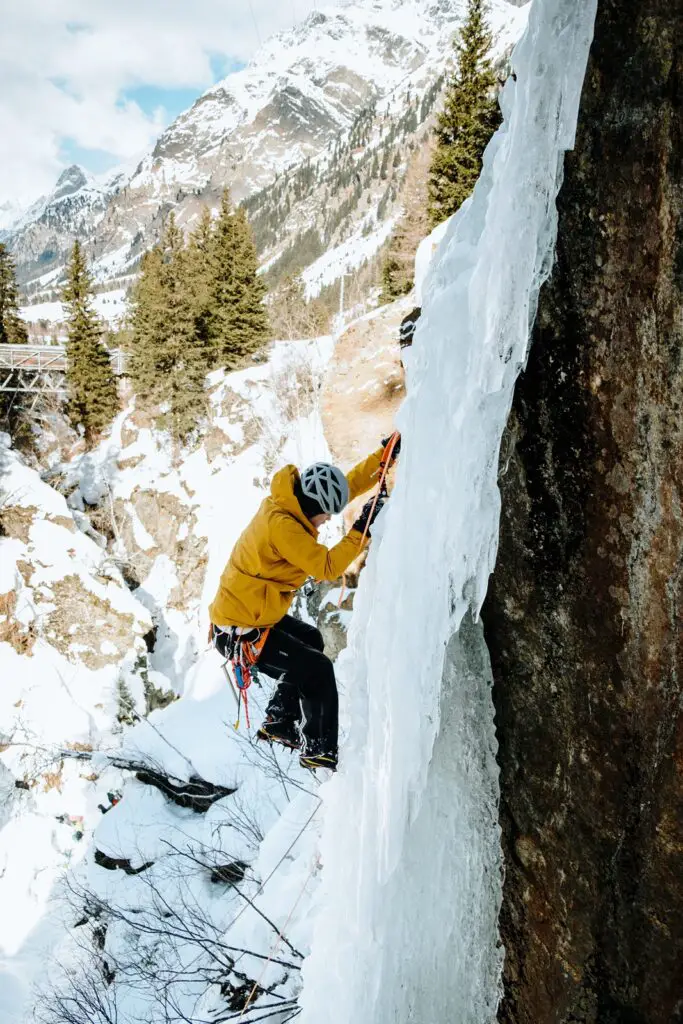
Can You Buy Used Ice Climbing Gear?
It’s hard to ignore the effects of climate change, and while ice climbing requires investing in a lot of gear, not all of it needs to be brand new.
Clothing and metal hardware, such as crampons, ice tools, ice screws, and carabiners are fine to buy used, proving they are in good condition.
However, any safety-related equipment, especially anything made out of material, such as ropes, slings, harnesses, and quickdraws, should only be purchased new.
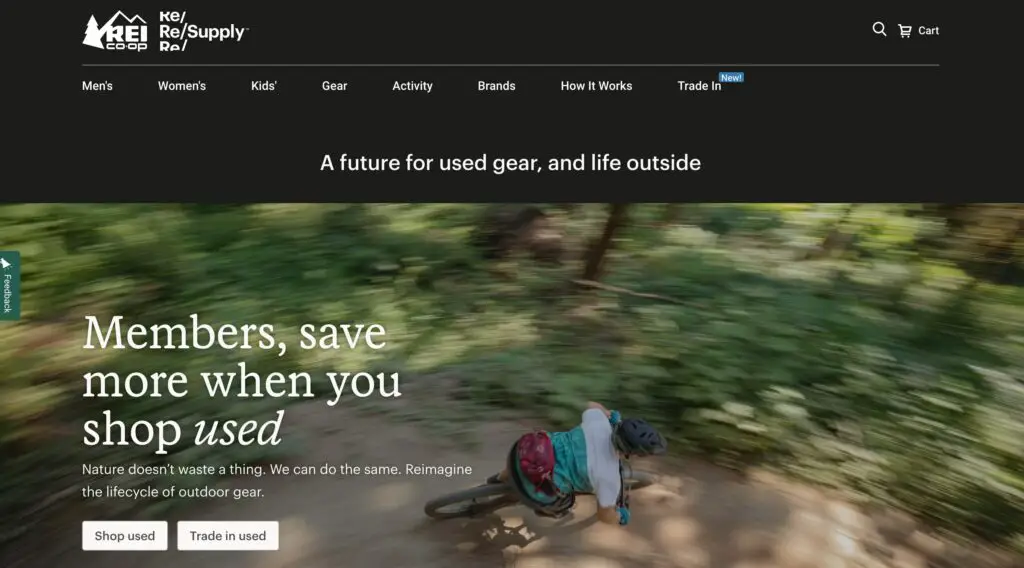
Summary
When you start ice climbing, it can be daunting to see how much gear you need (especially when you work out how much it all costs). But at the end of the day, having all the gear means you can set yourself up for fantastic ice climbing adventures.
Related Reading
Save This Post

